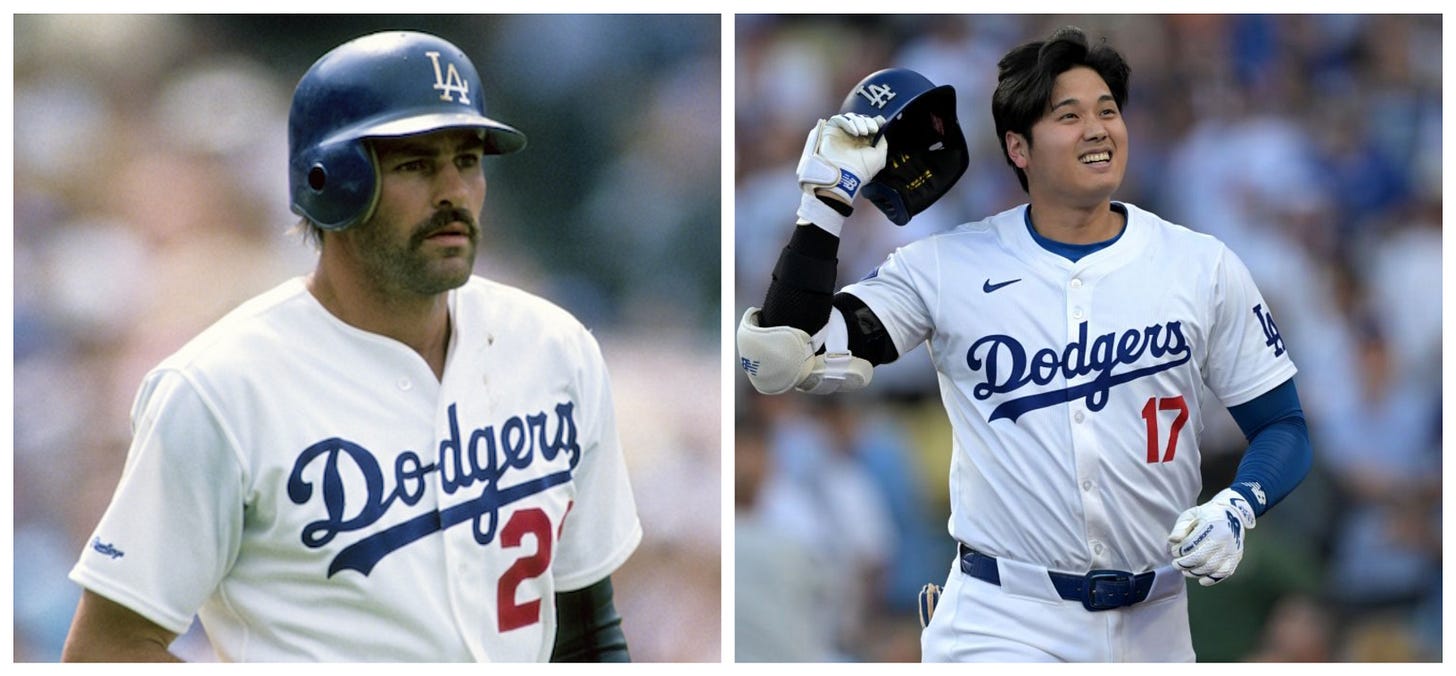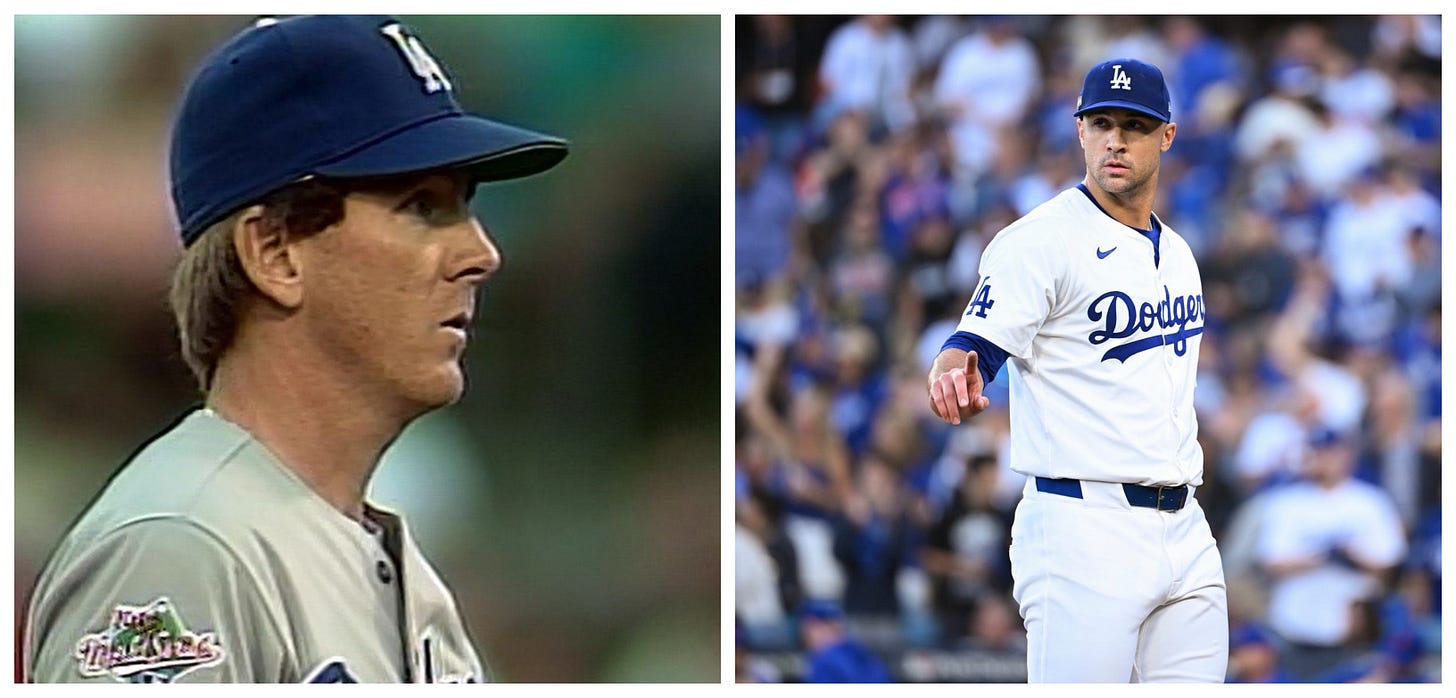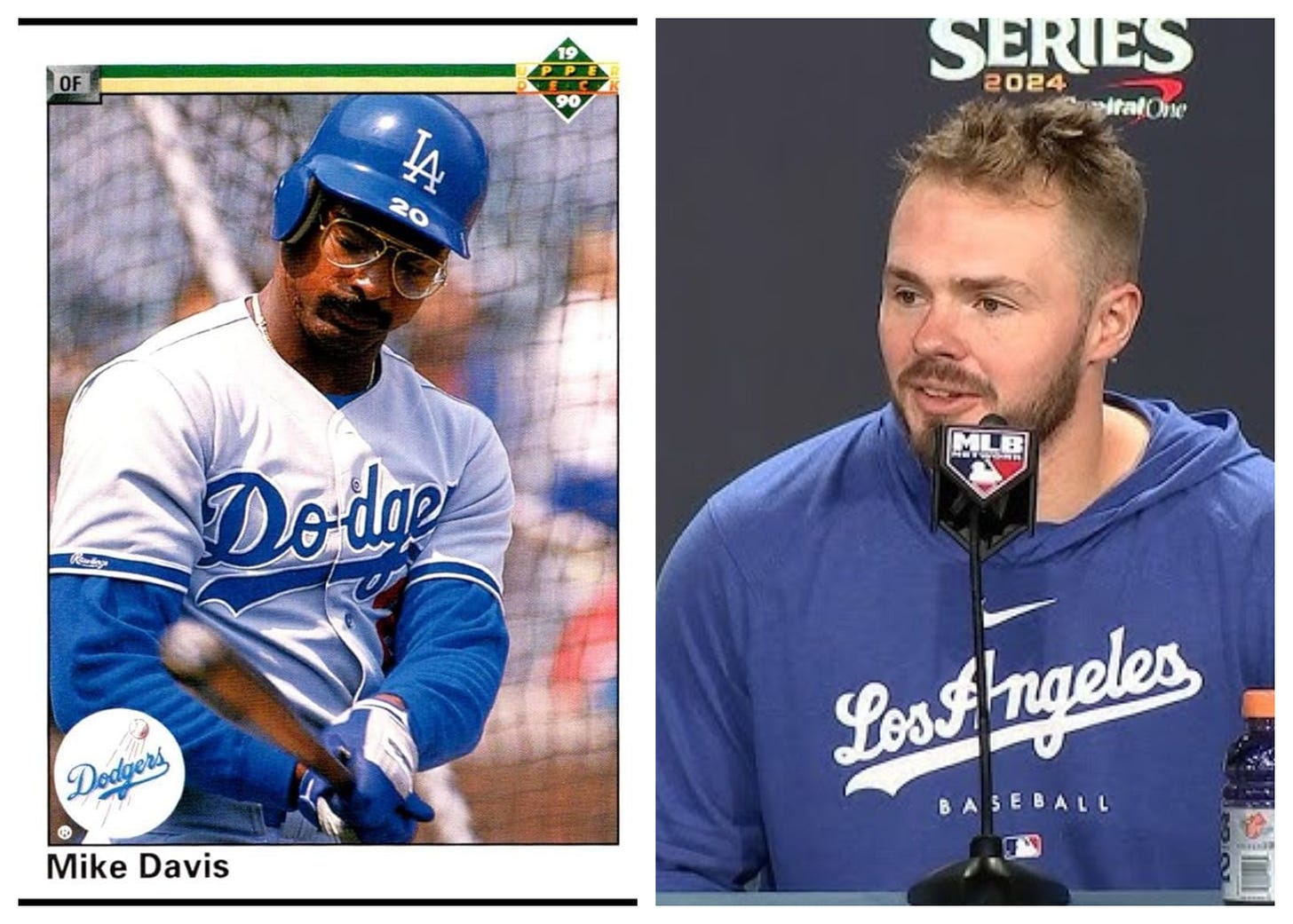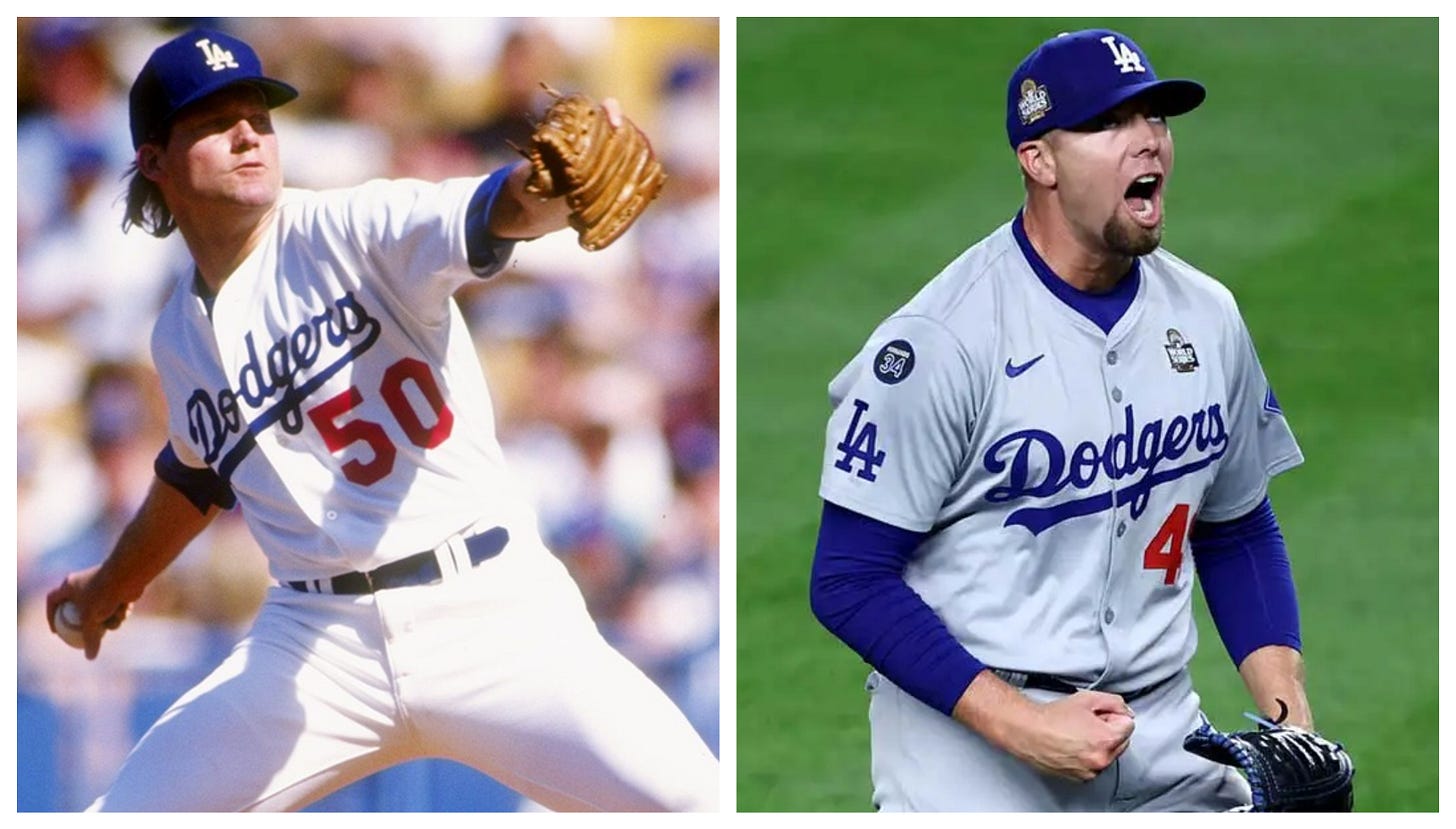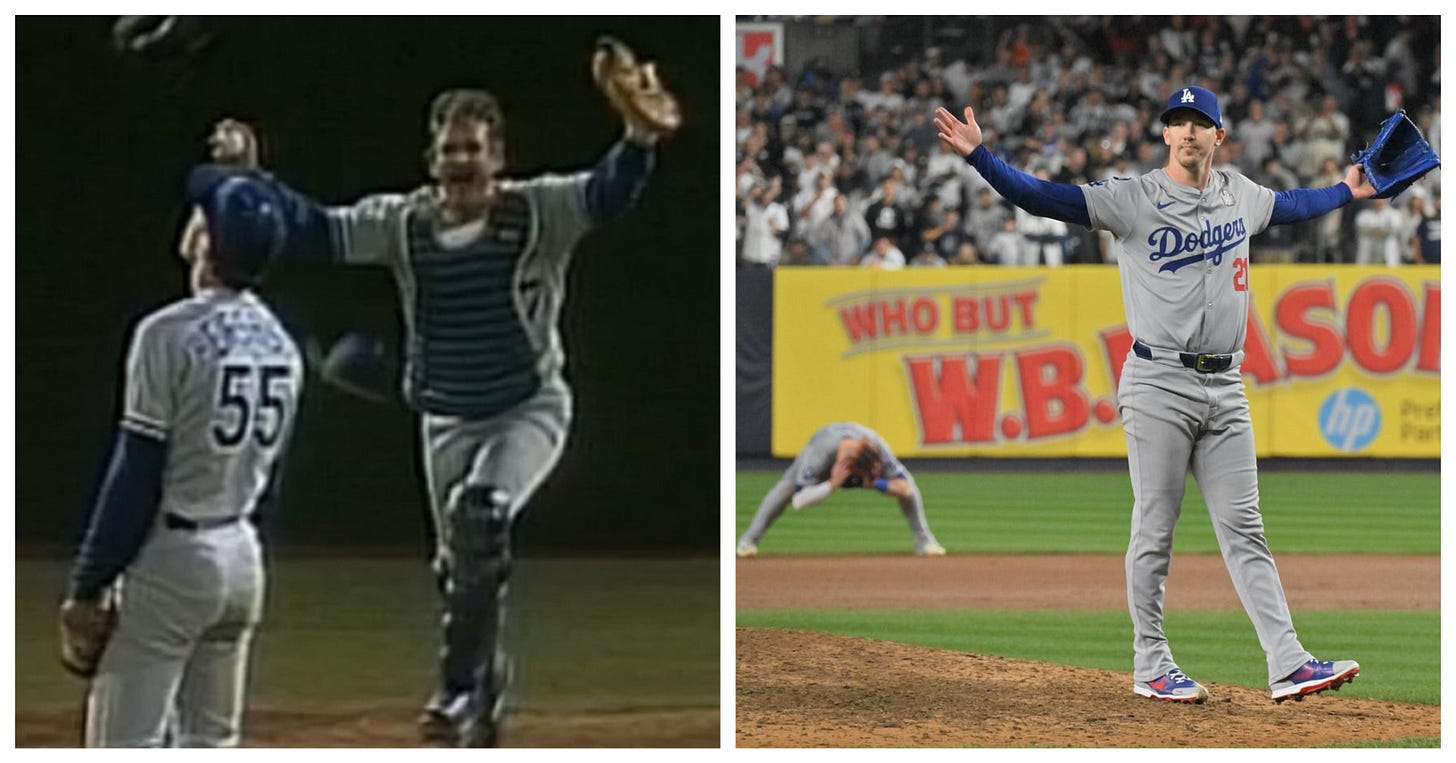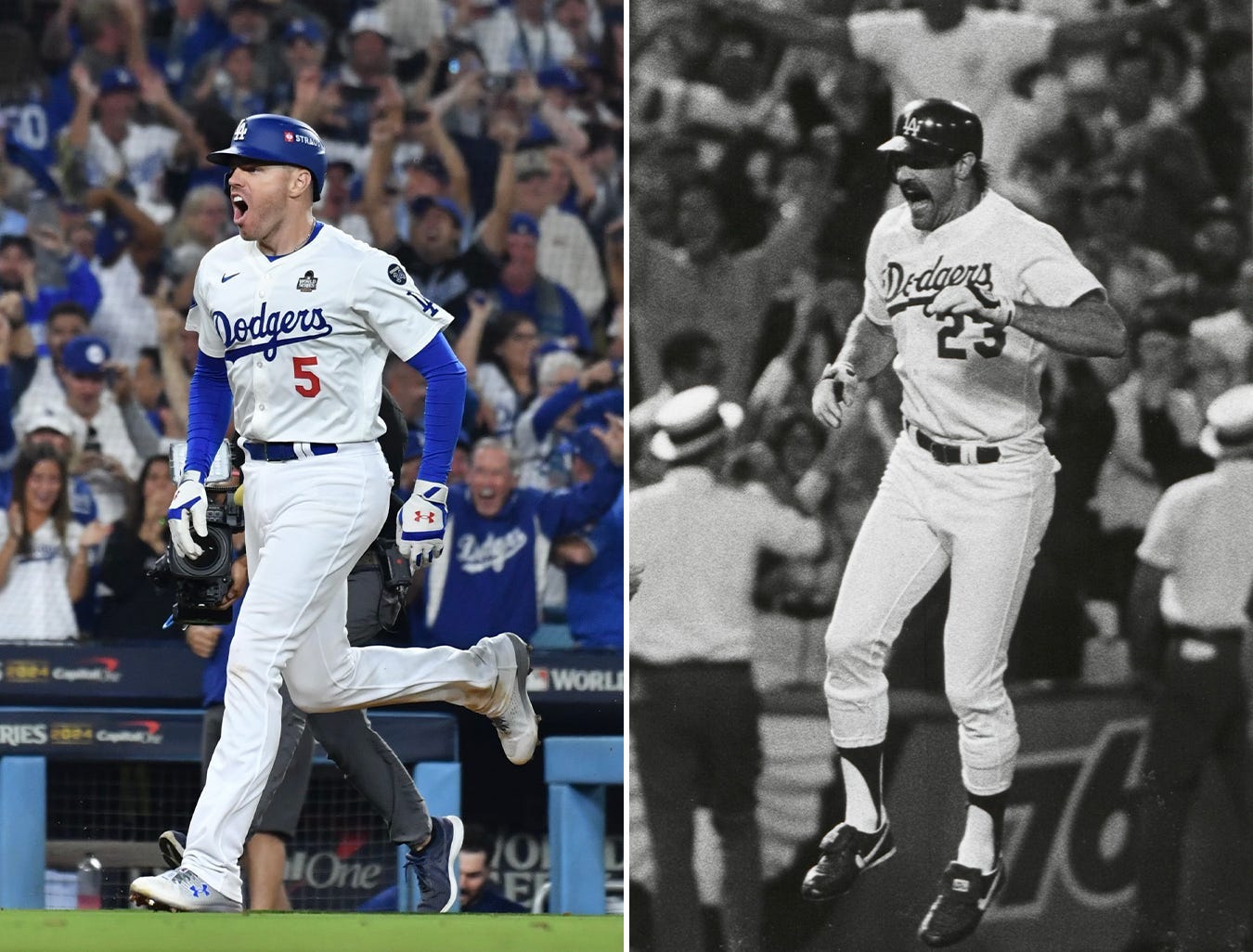1988 and 2024 Dodgers: Then and Now
36 years later, the next generation of Dodger champions have a LOT in common with the "Miracle Men."
Author’s Note: I had originally hoped to get this particular piece out immediately after the Dodgers won the World Series last month. However, I chose to err on the side of caution with respect to the NL MVP comparison. Obviously, there was no doubt Shohei Ohtani was miles better than Francisco Lindor. But clear statistical disparity hasn’t stopped voters from making absurd choices in the past (see: Terry Pendleton topping Barry Bonds for 1991 NL MVP).
Now, with Ohtani having officially secured his *third* unanimous MVP award, the show can officially go on. Enjoy!
During my research for the last chapter of my forthcoming 1985 World Series book, Interstate ‘85, I came across a small chart that intrigued me. In this chapter, I explore how the individual and shared legacies of the 1985 World Series came full circle when the Royals won it all again in 2015. In the issue of the Kansas City Star that commemorated Kansas City’s drought-busting championship, which I perused on Newspapers.com, I noticed a chart alongside one of the articles entitled Then and Now.
The chart was refreshingly specific in pointing out similarities between the 1985 and 2015 Royals’ title runs, including unique categories. One example was “Postseason Boost,” an underachieving regular season player who suddenly became clutch in October. In 1985, that honor belonged to David Letterman punchline Buddy Biancalana. In 2015, it was .255 regular season right fielder Alex Rios (in the last season of his career no less) who inexplicably balled out when it mattered most.
Especially when a team undergoes a significant gap between titles, the passage of time between them is fascinating to gauge in multiple ways. One way in which I like to compare neighboring championships separated by a long period of time is pointing out uncanny similarities. With the specificity of that K.C. Star chart in mind, I wanted to do my own version of this kind of reflection to measure the journey from 1988 to 2024 for my Dodgers.
As it turned out, the mirror images between both champion squads are not only numerous, but so improbable, you begin to believe baseball is a supernatural universe that operates with its own logic. From Gibson to Shohei, Howell to Treinen, and more, here’s how the reigning 2024 World Series Champion Los Angeles Dodgers perfectly mirror their “Miracle Men” ancestors of 1988.
Offseason MVP Signing to Redeem Recent Underachievement Who Battled Through Injuries in the Playoffs
Then: Kirk Gibson
Following their heartbreaking demise in the 1985 NLCS, the Dodgers sunk into a rare stretch of irrelevance, with back-to-back 73-89 seasons in 1986 and ‘87. To add further embarrassment, executive Al Campanis sullied the 40th anniversary of Jackie Robinson’s debut in April 1987 by making horrendously racist remarks on Nightline that led to his swift ouster.
On January 29, 1988, the Dodgers inked the cure to their recent ills: Kirk Harold Gibson. Gibson, a ferocious Detroit Tigers outfielder from 1979-1987 whose hard nosed tenacity helped key the team’s 1984 championship, was just what the lazy Boys in Blue needed. After owner collusion stymied Gibson’s free agency aspirations for years, “Gibby” didn’t hesitate to assert his leadership. He chewed out his new teammates for their recent underachievement, and provided leadership on-field that lifted an otherwise mediocre team to the postseason.
In the NLCS against the Mets, Gibson continued to lead, his solo home run in extras proving the difference in the white knuckle fourth game at Shea Stadium. In Game 5, he launched a three-run clout to put the game out of reach. The Dodgers won the pennant in Game 7, but Gibson’s tenacity came with a price: he injured his left hamstring in Game 5, and his right knee in Game 7.
As a result of his injuries, he only managed one at-bat in the World Series. But…I think it went pretty well.
Now: Shohei Ohtani
Similarly, the Dodgers rolled into the offseason following 2023 with an even greater circuit of underachievement under their belts. To that point, Los Angeles had enjoyed 11 consecutive postseason trips, one of the greatest playoff appearance streaks in MLB history. However, that run had only produced a lone championship, won in the 60-game pandemic season of 2020.
Thus, it was time to go bigger than ever. The target: Angels dual slugger/ace Shohei Ohtani. When the Dodger brass met with Ohtani, their pitch to him was unique: failure. In their view, their decade of consistent playoff appearances, with scant championship pedigree, was a failure. That stuck with Ohtani, who agreed to a heavily deferred 10-year contract that changed baseball forever.
Ohtani immediately made history, almost nonchalantly creating the 50/50 club on the same day the Dodgers clinched their 12th straight playoff spot. His three-run homer in Game 1 of the NLDS against San Diego saved the entire postseason. Like Gibson, however, Ohtani couldn’t escape injury in the later rounds. In Game 2 of the World Series, an attempted stolen base resulted in a shoulder injury that caused enough discomfort to send the Los Angeles faithful into a panic. That he played through it the rest of the Fall Classic is incredible.
The Former Cardinal Pitcher Acquired By Trade Midseason Due to Injuries
Then: John Tudor
For most of the ‘80s, Fernando Valenzuela (sigh…RIP) was a beacon of pitching dominance on par with Sandy Koufax. 1988, however, wasn’t so smooth for “El Toro.” He struggled for much of the season, and ultimately had to watch from the dugout for the last two months due to a left shoulder injury.
With Valenzuela out of commission, the Dodgers were in dire need of a left-handed ace. Enter John Tudor, the crafty St. Louis Cardinals southpaw who helped sink L.A. in the NLCS just three years before. On August 16, Los Angeles flipped star outfielder Pedro Guerrero to St. Louis for Tudor, who filled the gap nicely the rest of the way. Tudor went 4-3 with a 2.41 ERA in Dodger Blue, and pitched solidly in the NLCS.
Unfortunately, Tudor would develop an elbow injury during the Dodgers’ march to the title, as shown during his labored, abbreviated start in Game 3 of the World Series. Despite amassing an amazing comeback in 1990 with the Cardinals, he retired after the season. At the very least, after heartbreaks in the 1985 and 1987 World Series, he got his ring in ‘88.
Now: Jack Flaherty
History sure has a way of repeating itself in oddly specific ways, doesn’t it? If the 1988 Dodgers were hampered by Valenzuela’s injury, the 2024 squad had a much bigger crisis with the parade of injuries that decimated their rotation. River Ryan, Tyler Glasnow, Gavin Stone, Clayton Kershaw…it seemed like every time Dodgers fans woke up, another big arm was headed for the IL and, in some cases, Tommy John surgery.
By the time of the trade deadline, it was imperative Andrew Friedman land an ace. In a Mookie Betts-level steal, he snagged Jack Flaherty from the Detroit Tigers for a pair of marginal prospects. Flaherty, of course, first established himself as an ace with St. Louis from 2017-2023. Like Tudor 36 years prior, Flaherty was just the arm the Dodgers needed, going 6-2 with a 3.58 ERA as Los Angeles settled in and won the division with an MLB-best 98 wins.
After an up and down postseason, Flaherty completed the mirror image by pitching just 1 ⅓ innings in Game 5 of the World Series, similar to Tudor’s same length in Game 3 of the ‘88 Fall Classic (granted, that stunted outing was because Tudor’s arm was basically coming out of its socket). Not that either short turn hurt the Dodgers’ hopes of winning the title in five games, especially in Flaherty’s case.
The Guy Who Drew a Walk to Set Up the Miracle Home Run in Game 1, and Then Helped Win Game 5
Then: Mike Davis
Throughout the ‘80s, Mike Davis thrived as a solid hitter for the Oakland Athletics. After signing with the Dodgers as a free agent, however, Davis endured a horrific first season in Los Angeles in 1988, batting just .196 in 108 games. His struggles were enough to cost him the starting right fielder position he enjoyed on Opening Day.
In Game 1 of the World Series, however, Davis would put all of those frustrations behind him in a modest, but crucial, way. With two outs and nobody on base, Davis stood in against the nonpareil Dennis Eckersley, who issued a mere 11 walks through 72 ⅔ during the regular season. However, Eckersley may have been overly cautious about his former teammate’s power capabilities, walking him on just five pitches.
Davis proceeded to steal second. Then, he took off when pinch-hitter Kirk Gibson made contact on a backdoor slider. The rest is history. He further ensured the title with a two-run blast in the clinching Game 5.
Now: Gavin Lux
Since his debut in 2019, Gavin Lux has - to put it gently - been a divisive figure amongst the Dodger faithful. Many see him as a bust, while others (often known as “Lux Truthers”) insist he’s a star player eternally on the cusp of a breakout. His 2024 season was a microcosm of those battling factions, his seesaw vacillation between hot and cold streaks netting a .251 batting average through 110 games.
Similar to Mike Davis, Lux put his regular season frustrations behind him with a clutch walk when it mattered most. After the Yankees took a 3-2 lead in the top of the 10th, Will Smith started the bottom half by flying out against reliever Jake Cousins. Lux followed with a walk, advancing to second on a Tommy Edman single. In came Nestor Cortes, who proceeded to retire Shohei Ohtani to start his first appearance in a month. Then, after intentionally walking Mookie Betts, all he had to do was retire an injured Freddie Freeman to secure a Yankees Game 1 victory.
That…well…didn’t happen. As everyone across the world knows, Gibby met Freddie. And just as Mike Davis deserves wider respect for making Gibson’s blast possible, Lux deserves a similar degree of eternal admiration for giving Freeman a chance to do the same. Also, like Davis, he was clutch again in the clinching fifth game, tying the score at 6 with a sacrifice fly in the top of the 8th.
The Relievers Who Set Up the Miracle Home Run, But Will Unfairly Be Underappreciated For Their Efforts
Then: Tim Leary, Brian Holton, and Alejandro Pena
Kirk Gibson and Freddie Freeman’s hobbled miracle blasts speak for themselves, and will both be replayed infinitely 100 years from now. Yet if there’s anything approaching a downside to these transcendent moments, it’s that they overshadow the heroics of those who made them possible in the first place. Specifically, the relief pitchers.
In Game 1 of the 1988 World Series, Dodgers starting pitcher Tim Belcher didn’t fare well, lasting only two innings and coughing up a grand slam to Jose Canseco that dented a TV camera in centerfield. That blast, courtesy of one of the “Bash Brothers” that made Oakland the odds-on favorite, seemed to portend a crushing Athletics romp.
The bullpen had other plans. Tim Leary, Brian Holton, and Alejandro Pena followed Belcher’s truncated outing with seven combined scoreless innings to keep the game in reach. Pena in particular put an exclamation point on things, slapping his glove emphatically after striking out Canseco in the top of the 9th. To say the least, his enthusiasm was rewarded with a win on his record for the ages.
Now: Anthony Banda, Brusdar Graterol, Alex Vesia, Michael Kopech, and Blake Treinen
Game 1 of the 2024 World Series differed in that starter Jack Flaherty was mostly brilliant, save for coughing up a two-run homer to Giancarlo Stanton in the 6th that ended his night. Nevertheless, an even bigger caravan of relievers held the line for 4 ⅔ innings. A big chunk of “The Dawgs,” Anthony Banda, Brusdar Graterol, Alex Vesia, and Michel Kopech, didn’t allow a single run. Blake Treinen would barely let the dam burst in the top of the 10th on an Anthony Volpe groundout.
That 3-2 Yankees lead, however, wouldn’t hold.
The Reliever Who Stifled The Last Real Threat of the World Series
Then: Jay Howell, Game 4
After a stellar season as the Dodgers’ primary closer, the 1988 postseason got off to a rough start for Jay Howell. During the NLCS, Howell was ejected during Game 3 and suspended for three days for having pine tar on his glove. On paper, it should have been a fatal blow for the “Miracle Men.” Instead, Orel Hershiser just became even godlier, including closing Game 4 in relief.
Come World Series time, Howell was back in action. However, his first outing was a tough one, surrendering a walk-off homer to Mark McGwire in Game 3 that cut the Dodgers’ series lead to 2-1. Howell found a chance at redemption the following night in Game 4. In the bottom of the 7th, with the Dodgers clinging to a 4-3 lead, Howell faced McGwire again with the bases loaded and two out. This time, McGwire was readily dispatched on a popfly to first, and Howell cruised to a save that put L.A. up 3-1 in the World Series. Hershiser capped everything off in magnanimous fashion the following day.
Now: Blake Treinen, Game 5
While subject to no suspension in the 2024 postseason, Blake Treinen nonetheless faced his own share of adversity. After his ballsy efforts to down the Padres in the NLDS, and another stellar outing to close out the NLCS, Treinen’s sailing in the World Series wasn’t quite as smooth. He surrendered a lead in the top of the 10th inning in Game 1, but ultimately got the win thanks to the greatest grand slam ever. In Game 2, Treinen came on for the save in the 9th with a 4-1 lead, but let the Yankees score a run and load the bases before departing after a clutch strikeout. Alex Vesia came in for a one-pitch save to rescue the day.
Treinen’s deciding moment came in Game 5 at Yankee Stadium. But, it wouldn’t come easily. After the Dodgers clawed their way back from a 5-0 deficit to take a 7-6 lead in the top of the 8th, Treinen, who came into the game in the bottom of the 6th, assumed the mound once more. After retiring the first batter, he got in another jam. Manager Dave Roberts came out with doubt, only for a powerful exchange on the mound to change his mind. Treinen vindicated the decision to leave him in.
The Bulldog Ace Who Secured the Final Out
Then: Orel Hershiser
1988 was like walking on clouds for Orel Leonard Hershiser IV. The regular season saw him break fellow Dodger legend Don Drysdale’s scoreless inning streak. Then, he muscled out a save and a clinching complete game against the favored New York Mets to earn NLCS honors. (It should be noted that said save in Game 4 came *the day after* he pitched seven innings in Game 3.)
As for the World Series? Not much: just another round of MVP honors predicated on two complete game victories. In Game 2, he aided his shutout by lacing an RBI double in the 4th inning. In Game 5, he clinched the championship with such overpowering mastery it’s a shock he even allowed two runs. After striking out Tony Phillips to seal the deal, he seemed to tilt his head upwards and mutter a prayer of gratitude. The bounty of dominance earned Hershiser World Series MVP, and additional honors as Sports Illustrated Sportsperson of the Year.
Now: Walker Buehler
Unlike Hershiser, Buehler’s 2024 regular season won’t grace any magazine covers. After missing all of 2023 due to Tommy John surgery, Buehler was met with much turbulence in the 2024 regular season. He went a mere 1-6 with a bloated 5.38 ERA, seeming to indicate his former potency was sapped by two TJ surgeries.
Then, once the calendar flipped to October, it was like none of those struggles existed. Buehler has said his reputation as a big game pitcher is “kind of all I care about.” He showed it immediately in Game 3 of the NLDS, pitching brilliantly even as his stat line was marred by atrocious defense. In Game 3 of the NLCS, he gutted out four innings at Citi Field to ensure a victory, followed by five gutsy innings in Game 3 of the World Series to put the Dodgers on the doorstep of the title.
In Game 5, with only two days of rest, Buehler saw action again. Yet, it was only because he lied to pitching coach Mark Prior about doing his usual pregame throwing routine. That lie wouldn’t matter, as he blazed through the 9th with ease. Unlike Hershiser’s relaxed utterance, Buehler was hardly subtle in crowning the title after striking out Alex Verdugo, stretching his arms out in a Gladiator-style show of triumph before his teammates mobbed him.
The synchronicity of the Bulldog and the Buehldog reached its zenith during the celebration parade in Los Angeles. As the 2024 champions drove by seas of Angelenos en route to a ceremony at Dodger Stadium, Buehler waved at everyone while wearing Hershiser’s original 1988 World Series jersey. After more than three decades of Dodgers fans having to live off of the glory of ‘88, the iconography of the Miracle Men being passed down directly with new relevance was extra sweet.
The Hobbled MVP Who Blasted a Walk-Off Homer in Game 1 That Will Be Replayed Eternally
Oh come on. Do I really need to explain this one at length?





